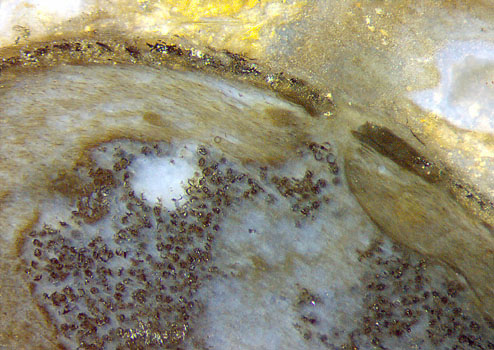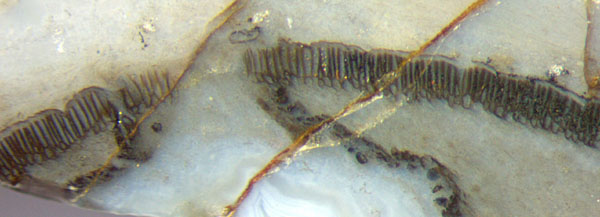Holes gnawed
into early land plants by
elusive creatures
Some of the various phenomena of damage to live
plants are known from the Lower Devonian. A few
specimens of the early land plants as those preserved
in the Rhynie chert show
signs of having been affected by some unknown agent. Most conspicuous
are the big radially oriented void patterns occasionally appearing
on cross-sections of Aglaophyton
(Fig.1). They are certainly not due to creatures but represent a growth anomaly
probably
caused by some unidentified fungus pervading the tissue. Cavities
of quite another type are those left by herbivores, like
the one also seen in Fig.1, above right, and those in Figs.2,3.
Fig.1 (left): Cross-section of Aglaophyton with
"flower-shaped" pattern
of voids due to misguided growth, probably
under the influence of some fungus, and with an additional hole in the
tissue. Image width 4.4mm.



Figs.2,3: Cross-sections
of Aglaophyton
with cavities eaten into the tissue by some unknown creature able to
make an entrance, feed, and retreat.
Image widths Figs.2,3: 4.3mm, 2mm.
By
lucky incidence the cut plane in Figs.2,3 reveals the access hole.
The peculiar shape of the cavity with entrance suggests the idea that a
lengthy creature crept half in, turned to either side while feeding,
then retreated backwards. The creature seems to have visited its
feeding place repeatedly since it could hardly have eaten the amount of
tissue at one time.
Apparently there were creatures demanding food
other than mere parenchyma tissue. They
had gnawed holes into
spore capsules with the intent to get at the spores (Fig.4). Since the
chance of finding a hole on an arbitrary sample face is small, and a
few
have been found on sporangium
walls, they are not quite rare. (The very existence of holes in
sporangia of Aglaophyton
was
doubted not long ago, in 2004.)
The
outer sporangium wall consisting of the so-called palisade cells,
apparently meant to scare off offenders, had been removed locally to
make the access hole seen in Fig.4.
With another sample, a cavity in the inner sporangium wall
with loose spore tetrads incidentally fallen in is seen in Fig.5. Remains of the
decayed outer wall are
hardly visible at the bottom of the frame. 

Fig.4 (left):
Aglaophyton
sporangium with hole gnawed through
the outer and inner wall.
Image width 3.4mm.
Fig.5: Aglaophyton
sporangium detail: cavity
eaten into the inner
wall, scattered spore tetrads.
Image width 2mm.
Fig.6 (below): Aglaophyton
sporangium wall with cavity and access hole in the
"palisade wall".
Image width 3mm.

The damage had been done to the live
plants as can be concluded from repair
activities also seen in similar
cases. This clearly contradicts the statement in [1], p47, that "There
is no evidence of animals that eat living, growing plant material."
What
remains to be done is to find the creatures which made the holes. This
will be difficult since no creature has been seen in these
chert samples. It may be
concluded from Fig.2 and Fig.6 that the diameters of the access holes are about 0.4mm.
There must have been creatures able to
squeeze themselves through these holes.
Other indications of the potential presence of unseen creatures looking for
spores are provided by Nothia
with its big
tubes probably containing poisonous liquid serving as a
repellant, also by Trichopherophyton
with its pointed bristles.
The holes gnawed through unprotected capsule walls and the apparent
precautions against attack on sporangia, like
bristles and poison,
seem not compatible with the statement that "The evidence for
deliberately targeted spore-feeding in the Early Devonian is not
conclusive" [2]. Spherical
or ellipsoidal clots
consisting of spores, possibly taken from sporangia and carefully glued
together, also seem to
support the idea of spore feeding.
To sum up, access holes and cavities had been eaten
into live specimens
of the early land plant Aglaophyton
by elusive herbivores.
Samples:
RhX/1.2 (1.33kg): Fig.1. Rh6/78.2
(0.1kg) found
in 2003: Fig.2. Rh15/84.1 (1.3kg)
obtained from Barron in
2014: Fig.3.
Rh2/75.11 found before 2004: Fig.4.
Rh2/98.1 (9.5kg)
obtained from Shanks
in 2003: Fig.5. Rh6/38.2
(about 0.2kg) found in 2003:
Fig.6. Weights refer
to undivided samples.
H.-J.
Weiss
2021
(slightly modified version)
[1] P.G. Gensel, D. Edwards (eds.): Plants Invade the Land. Chapter 3: W.A. Shear, P.A. Selden: Rustling in the Undergrowth. Columbia Univ. Press (2001).
[2]
K.S. Habgood, H. Hass, H. Kerp:
Evidence for an early terrestrial food web: coprolites from the Early
Devonian Rhynie chert.
Proc.
Roy. Soc. Edinburgh, Earth Sci. 94 (2004), 371-389.
 |
 |
180 |









